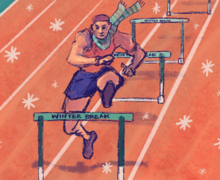Tommy DeVito’s trainer elaborates on quarterback’s decision to transfer
Rich Barnes | USA TODAY Sports
Tommy DeVito filled in for Dungey several times during SU’s 10-3 season in 2018.
Get the latest Syracuse news delivered right to your inbox.
Subscribe to our sports newsletter here.
Two hours before Syracuse’s Sept. 24 game against Liberty, head coach Dino Babers met in a hotel with his two quarterbacks, Tommy DeVito and Garrett Shrader. DeVito, the Orange’s starter since 2019, had started the team’s first three games, but Babers wanted a change. He went with Shrader, who led SU to a 24-21 win over Liberty that night.
DeVito was shocked by Babers’ decision, he later told ESPN Radio. He had taken first team practice reps the entire week in practice, only to be replaced by Shrader, the Mississippi State transfer who had posted similar statlines to DeVito in Syracuse’s first three games.
After the Liberty win, DeVito didn’t appear in SU’s next three games against Florida State, Wake Forest and Clemson. The Orange’s offense became more lenient on a rushing attack led by Shrader and Sean Tucker, the nation’s leader in all-purpose yards. The pass-first offense from Babers’ first five years as head coach disappeared, and so did No. 1 wide receiver Taj Harris — who entered the transfer portal after the FSU game — and eventually, DeVito left, too.
Syracuse’s offense struggled against Clemson, scoring just 14 points. Shrader went 17-for-37 passing against the Tigers, and he missed several open receivers on short throws. And despite moving back to the pass-heavy offense DeVito specializes in, the New Jersey native saw no playing time in the three-point loss. Just two days later, he entered the transfer portal after having a conversation with Babers that the head coach declined to elaborate on during his Monday press conference. Neither DeVito nor his father Tom immediately responded to requests for comment.
“When Syracuse needed him the most (against Clemson), they opted not to go with him,” DeVito’s longtime quarterback coach Leon Clarke told The Daily Orange Monday morning. “And the offense just wasn’t moving the ball and they still didn’t turn to him. So at what point are you going to play him?”
Clarke spoke with The D.O. one day after DeVito’s decision to leave the program he committed to April 2016 and was expected to lead after Eric Dungey graduated in 2018. Clarke said the tipping point for DeVito came after not appearing against Clemson on Friday night, although DeVito initially did not want to leave the program after losing the starting position.
DeVito filled in for Dungey several times during SU’s 10-3 season in 2018. Against UNC, Babers brought in the then-redshirt freshman in relief after the offense stalled, and DeVito responded by throwing for three touchdowns, including a game-tying, 42-yard one to Nykeim Johnson late in the fourth quarter. Syracuse went on to win in overtime.
Although DeVito competed against Dungey for the starting quarterback job that season, there was little competition with Shrader after the Liberty game — even when the offense struggled — Clarke said.
Initially after being benched, Clarke told DeVito to be a good teammate and set a “good example.” DeVito compared the situation to when Alabama benched Jalen Hurts for Tua Tagovailoa but Hurts continued to stay ready in case he needed to play.
Syracuse’s offense became more run-heavy after Shrader became the starting quarterback. Without Harris, the pieces weren’t “there anymore,” Clarke said, and the offense “just didn’t fit (DeVito’s) skill set.” Harris departed in part, Clark noted, because he didn’t have a quarterback like DeVito throwing to him. DeVito is known for his strong arm and ability to throw accurate deep passes to receivers like Harris, but he isn’t known for his ability to run the ball.
Against Wake Forest, Syracuse ran the ball 58 times and only threw 27 times. Shrader himself ran 29 times, and Babers leaned on an option-based rushing attack. DeVito didn’t “see this changing” and felt he needed to find a team that could utilize his skill set better, Clarke said. He also said DeVito is looking for a team with a balanced, pro-style offense and a strong offensive line that can protect him in the pocket.
SU’s offensive line struggled with injuries and overall consistency during DeVito’s years as a starter, and he ranked near the bottom of Football Bowl Subdivision teams last year. A series of injuries contributed to fullback Chris Elmore lining up at right guard last season, and the line’s play contributed to DeVito suffering a sack against Duke that ultimately ended his season.
“You’re playing with all the different pieces to the puzzle, and you’re trying to put them in to get them to fit,” Clarke said. “And then you’re also trying to run your system. And you’re saying, well, we want to play fast. We want to play fast. And how can (you) get to play fast when (DeVito’s) playing with spare parts?”
Because DeVito redshirted in 2017, he isn’t subject to the NCAA rule that states if a player plays four games or less in a season he keeps a year of eligibility, and Babers said DeVito didn’t save any eligibility by leaving in October as opposed to the end of the season. DeVito played in three games this year against Ohio, Rutgers and UAlbany.
Clarke said DeVito could’ve left SU after last season, especially after the leg injury, but there were conversations between DeVito, his family and Clarke about how Syracuse would have an improved offensive line and running game. So DeVito returned to Syracuse for another season.
But now, there are younger quarterbacks like JaCobian Morgan and Dillon Markiewicz on the roster who need to develop, Clarke said, and instead of taking away valuable reps from them, DeVito will enter the transfer portal. Clarke said there is no resentment toward Babers or Shrader, and Babers added DeVito is “always going to be Orange.”
“He was very clear. He was very mature,” Babers said. “I was proud of the way he handled it. And that’s why I will do anything for him in the future.”
Published on October 18, 2021 at 4:18 pm
Contact Connor: csmith49@syr.edu | @csmith17_






